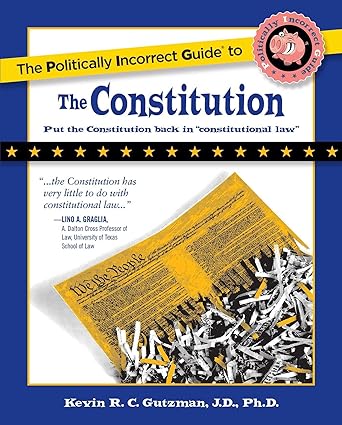Books Reviewed
Given the hash that has been made of the United States Constitution by the modern Supreme Court, ordinary citizens who suspect foul play, but who lack any prior study of what passes for “constitutional law” nowadays, might benefit from an informative, accessible guide to the Constitution’s true principles. Sadly, Kevin Gutzman’s Politically Incorrect Guide to the Constitution fills only half the bill. Accessible it is; informative it is not.
A book that “guides” the reader through the Constitution might take a variety of approaches—a topical one, for instance, such as a tour through the document’s articles and amendments. Gutzman, who teaches at Western Connecticut University and holds a law degree from the University of Texas, has chosen a chronological approach, tracing the development of the Constitution from the Revolution to the present. Not counting a very brief introduction and conclusion, the book has twelve chapters. Seven of them, comprising nearly two-thirds of the text, are spent before Gutzman has gotten us past the Civil War and its immediate aftermath. Focusing on early history might be a sign of an instructive attention to the principles of the founding. After all, getting right with the Constitution ought to require a careful understanding of its beginnings and its greatest crisis.
But alas, the first two-thirds of this book are wrongheaded, tendentious, and bizarre. The trouble begins with the Revolution. Gutzman asserts that “America was [not] founded on” the principles in the second paragraph of the Declaration of Independence, the one beginning “We hold these truths to be self-evident.” That stuff about human equality and inalienable rights was “hortatory” at best and at worst an illegitimate concoction of “a new theory of government.” So much for one of Gutzman’s putative heroes, Thomas Jefferson, who rightly thought this paragraph to be the heart of the matter. (It is far from clear that Gutzman understands that there was a Revolution; in defense of the South’s attempt to secede from the Union, he asserts that the United States “seceded from the British Empire.”) The idea that “sovereignty lay in the states,” our author avers, “was the first principle of American government.” But what makes state sovereignty itself legitimate? Gutzman never asks. He does not know a first principle when he sees one.
His attachment to state sovereignty causes him to misread every signal event of our early history. He believes that the criticism of the Articles of Confederation as inadequate to the needs of the Union—the view advanced by those who desired the very Constitution that is the subject of his Guide—was trumped up. He tells us that the Constitutional Convention was attended by three groups: “monarchists” like Alexander Hamilton, “nationalists” like James Madison, and defenders of “the primary place of the states” in the Union. He then ridiculously declares that the third group won all the decisive arguments at Philadelphia and in the ratification campaign, only to have their authentic constitutionalism betrayed by the authors of The Federalist, the administration of George Washington, the early Congress, and the Supreme Courts of John Jay and John Marshall. In fact, the founders understood the Constitution to be a compact of the American people acting within their states, not a compact of the states as independent peoples or political sovereigns. On behalf of limited self-government, it divided authority between the states and the national government, but it granted states no right of nullification or secession and forbade them to make alliances without the consent of Congress. Asserting “state sovereignty” as Gutzman does would deny the Constitution any authority at all. Readers can be excused for suspecting that he does not actually like the Constitution very much. He is the true heir of the man most unstintingly praised in The Politically Incorrect Guide to the Constitution, the “Virginia philosopher-statesman John Taylor of Caroline,” in truth an excitable crank whose turgid tomes on the Constitution are quietly and deservedly moldering on library shelves at our better universities.
* * *
The Supreme Court, especially under John Marshall, is Gutzman’s bête noir. Like many self-described conservatives, our author rails against the hunger for power he sees in the justices of the Court. But Gutzman wishes the Court had been more activist, not less so, throughout its history—on behalf of the states, that is, and against the national government. Gutzman’s Court would have declared the national bank unconstitutional, made federal navigation laws subordinate to conflicting state laws, ruled against Abraham Lincoln’s blockade of Southern ports, and outlawed conscription during World War I.
By the time we get to the later chapters on the genuinely egregious rulings of the modern Court, Gutzman has exhausted both his store of arguments and the intelligent reader’s credulity. Even when he is right, he substitutes denunciation for argument. One example will suffice: when he rightly condemns the “Incorporation Doctrine” that made the states subject to most of the strictures of the Bill of Rights, he simply announces that the doctrine is “plainly at variance with historical truth,” and leaves it at that. Really? Even the reader predisposed to agree might like an explanation.
Like Thomas Woods, the author of the earlier Politically Incorrect Guide to American History (see “Mainly Incorrect,” CRB, Spring 2005), Gutzman is a neo-Confederate who resents the course our history has taken since the first day of the Philadelphia Convention. In his potted constitutional history, Lincoln is a villain, Marshall is a scoundrel, The Federalist is guilty of “great confusion about the document,” and Madison—Madison!—is an untrustworthy guide to understanding the Constitution. Perhaps all you need to know is that Gutzman wastes two pages arguing that we shouldn’t call the Civil War “the Civil War.” Some of the PIG books on non-political topics seem to be useful. But as with the Woods volume, Regnery Publishing has here done the reading public a great disservice.




